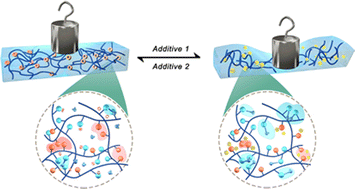Hydrogels with ultra-highly additive adjustable toughness under quasi-isochoric conditions†
Abstract
Bioinspired smart hydrogels with additive-switchable mechanical properties have been attracting increasing attention in recent years. However, most existing hydrogel systems suffer from limited stiffening amplitude and dramatic volume change upon response to environmental triggers. Herein, we propose a novel strategy to prepare additive-responsive hydrogels with ultra-highly adjustable toughness under quasi-isochoric conditions. The key point lies in tuning the softening transition temperature of the hydrogels with non-covalent interactions between the polymer networks and additives, shifting the hydrogels from glassy to rubbery states. As a proof of concept, a variety of glassy hydrogels are prepared and exposed to additives to trigger responsive performances. Young's modulus of the same hydrogel demonstrates up to 36 000 times ultra-broad-range tunability, ranging from 0.0042 to 150 MPa in response to different additives. Meanwhile, negligible volume changes occur, keeping the hydrogels in quasi-isochoric conditions. Interestingly, the mechanical behaviors of the hydrogels manifest remarkable dependence on the additive type and concentration since both the Hofmeister effect and hydrophobicity of the additives play pivotal roles according to mechanism investigations. Furthermore, the regulation with additives reveals satisfactory reversibility and universality. Taken together, this simple and effective approach provides a novel strategy to fabricate hydrogels with highly tunable toughness for versatile applications, including spatially patterned conductive gels and anti-icing coatings.



 Please wait while we load your content...
Please wait while we load your content...